The OnePlus 2 Review
by Brandon Chester on December 14, 2015 8:00 AM EST- Posted in
- Smartphones
- Mobile
- OnePlus
- OnePlus 2
Battery Life
It's fairly self-evident that achieving a long battery life is one of the most important aspects of a mobile device. A device can be incredibly enjoyable to use, but if its battery doesn't last very long you won't be able to enjoy it for any considerable period of time. There are also many elements that contribute to battery life, and certain use cases may be bound by a certain aspect more than others. For example, web browsing is actually a very display-bound type of battery workload, while gaming is a GPU-bound workload.
To gain an understanding of the OnePlus 2's battery life in various scenarios I've run it through our standard battery benchmark suite, which consists of our web browsing battery test, PCMark's mixed usage battery test, BaseMark OS II's CPU bound test, and finally GFXBench's GPU-bound test. As always, all devices are calibrated to 200nits except when their brightness curves necessitate testing above that value.
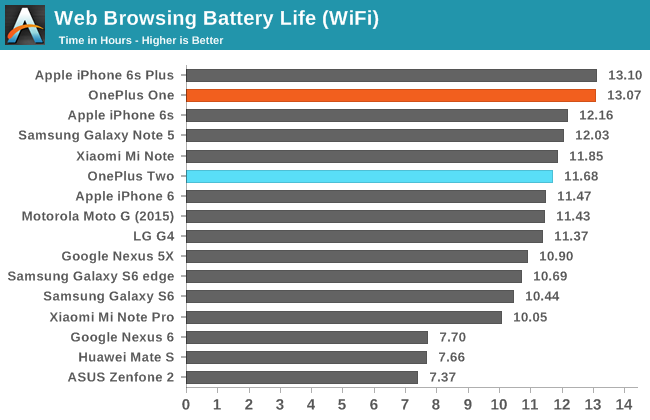
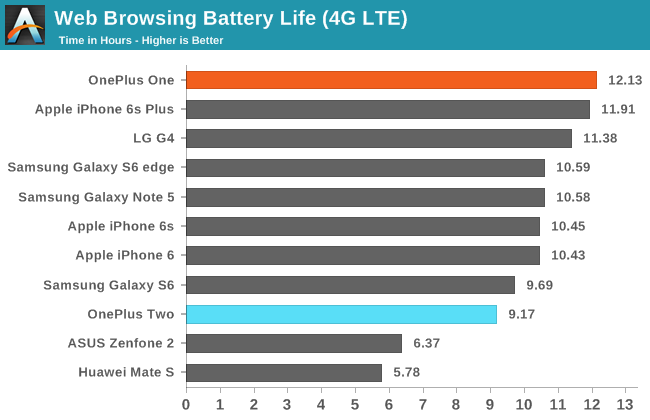
In our WiFi web browsing test there's definitely a noticeable regression in battery life going from the OnePlus One to the OnePlus 2, but both devices last over 11 hours so I don't think this presents a major issue. Battery life on LTE sees a more significant drop than the OnePlus One did, but it's worth noting that it's difficult to keep this test entirely consistent between editors due to different network frequency and signal strength in different nations, and so it's just to give an idea of what to expect when browsing off of WiFi.
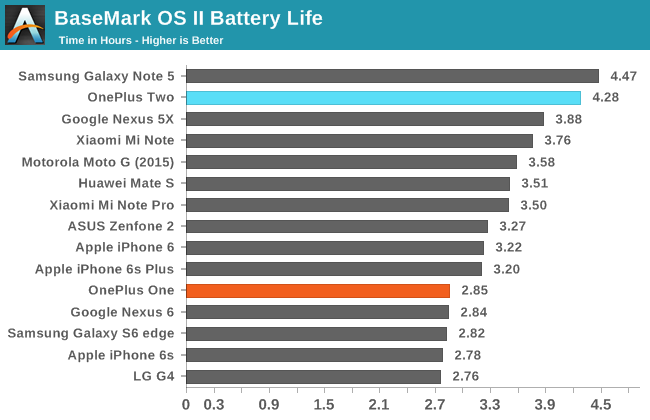
At first glance, the OnePlus 2 appears to do quite well in BaseMark OS II's battery test. When examining the behavior of the CPU during this test it's clear that the Cortex A57 cores shut off after about five minutes, and so you're left with four Cortex A53 cores. With that in mind, being able to run a CPU heavy workload for 4.28 hours is not that impressive when you have a 12.54Wh battery pushing four Cortex A53s.
It's worth comparing to the OnePlus One, which actually was a case of a device achieving both a high level of CPU utilization and high performance, and while it didn't last as long as the OnePlus 2 it's definitely more useful to sustain high CPU performance and achieve a shorter battery life than to sustain much lower performance for an hour and a half longer.
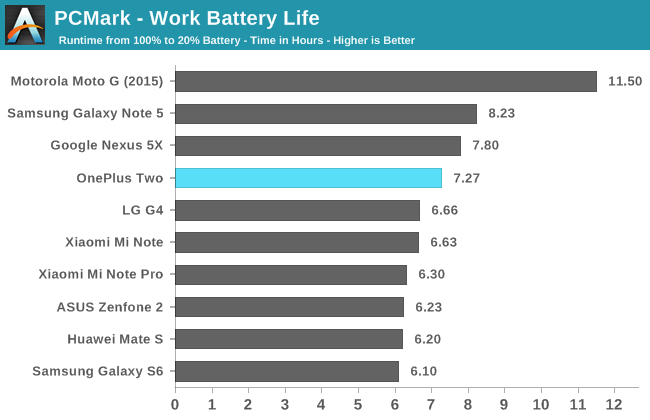
PCMark is a test that we actually weren't able to run on the OnePlus One due to the PCMark suite being a relatively new introduction to our benchmarking catalog. While this means we can't compare the OnePlus 2 directly to its predecessor, the fact that a device still needs to stand on its own means that this isn't necessarily a big deal. When looking at the OnePlus 2's battery lifetime of 7.27 hours it's clear that it has a notable lead over most other smartphones, although it's bested by the smaller Nexus 5X and the larger Galaxy Note5.
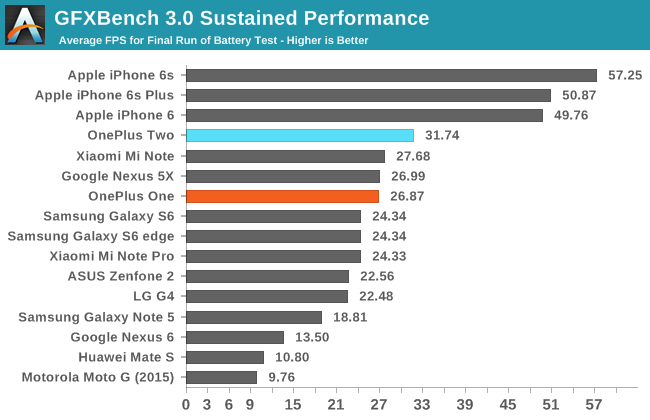
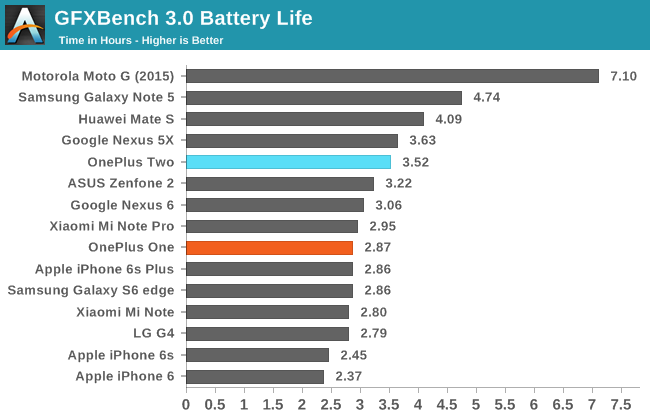
The fact that Adreno 430 is quite a good GPU coupled with a large battery allows the OnePlus 2 to perform very well in GFXBench's battery life test. When looking at sustained performance we see that after about 10 minutes it has dropped to around 32fps, and it sustains a very stable frame rate for the reminder of the test which speaks well of the thermal management going on. This is enough to put it at the top of the Android devices on our sustained performance chart, although it's still bested by Apple's latest and previous generation iPhones, which is partially due to the fact that the test renders on screen, although mostly due to A9's relative lack of GPU throttling. It lasts 3.52 hours before dying, which is one of the longer battery lifetimes that we've seen. One can safely say that the OnePlus 2 is a good phone for someone who wants to be able to run GPU heavy apps like games for a long period of time, although it's important to consider whether the CPU performance issues will end up bottlenecking performance in real world games.
While the OnePlus 2 is certainly not the most performant smartphone, one can say that the battery is more than enough to get you through the day. The performance and battery life demonstrated in GPU heavy workloads is notable, although the battery life in CPU heavy workloads is not very impressive once you consider how the phone is simply shutting off its Cortex A57 cores. If you need a balance between performance and battery life I would probably look elsewhere, but if battery life regardless of other factors is your priority when buying a device the OnePlus 2 will be a good fit.
Charge Time
One of the concerns that I've seen about the OnePlus 2 since its original announcement was the lack of support for Qualcomm's Quick Charge protocol. Since the OnePlus 2 has fairly substantial battery life, I don't think the lack of support for QC2.0 is a big problem, as you'll typically just be plugging the phone in at night. That being said, there aren't really any circumstances where quick charging makes the experience worse, and so the omission is a bit concerning.
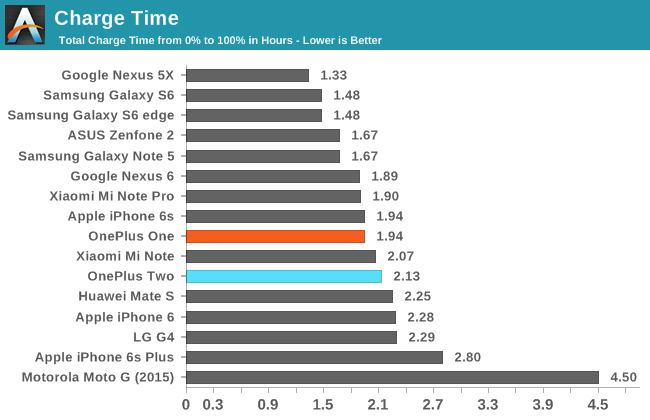
Charge time on the OnePlus 2 increases slightly from the OnePlus One, which isn't surprising given the slight bump in battery capacity. The charger that OnePlus includes in the box is a 5V 2A block, and as I mentioned above there's no official support for faster rates using QC2.0 chargers. For me, a two hour charge time isn't very bothersome considering the large battery, but I know that some buyers will take issue with the lack of QC2.0 support. The phone's tagline is "Never Settle" after all, so I think it's a valid point of frustration.
WiFi Performance
The OnePlus One used Qualcomm's WCN3680, which provided 1x1 802.11ac connectivity and Bluetooth 4.0 support. while the OnePlus 2 adopts their QCA6164A WiFi + Bluetooth chip which also supports 1x1 802.11ac and Bluetooth 4.0, although the software stack now supports Bluetooth 4.1 for improved LTE coexistence among other improvements. As far as WiFi performance goes, we're looking at the same theoretical peak throughput for both phones.
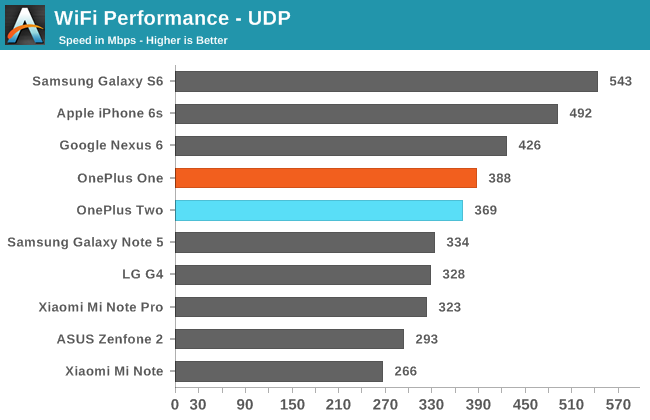
While there is a small gap between the results for the OnePlus 2 and OnePlus One, I'm sure if I ran the test many times I could eventually reverse the order due to testing variance. I think it's safe to say that the WiFi on the OnePlus 2 is as performant as its predecessor, and while it's not a 2x2 802.11ac implementation I think that you'll run into NAND or network limitations before the throughput of the WiFi chipset becomes a limiting factor.


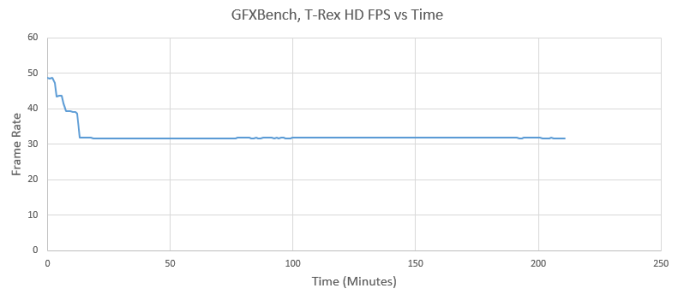








132 Comments
View All Comments
lucam - Monday, December 14, 2015 - link
Hahaha...lol!!!cuex - Monday, December 14, 2015 - link
Is it possible for you to give review using a custom kernel that allow the usage of A57 Cores in normal usage? Would like to know whether it's really the "hesistant of using A57 Cores" is the cause of slow-down...danielfranklin - Tuesday, December 15, 2015 - link
Yes you can, i have and its very fast.In fact ive calibrated my display as well and im quite impressed with it now, the high contrast really comes alive.
Unfortunately with further hacking OnePlus havent properly released their source code and Devs are leaving it in droves.
Im quite happy with it (got it on special) but i cant help but think they have alienated the power users with the lack of code and alienated the normal users with the CPU performance and lack of calibration on the screen.
Personally i think they have kind of lost the plot.
adityarjun - Monday, December 14, 2015 - link
Umm, sorry to hijack this thread but I am in the market for a 5inch-ish android phone. My requirements are a good battery and camera and a decent enough display and lag free UI interaction. I don't game. My current phone is Moto G 2014. I am looking at the 5x, OnePlus X and Moto X 2014. I favor the last. Is it still a good buy?mcbhagav - Monday, December 14, 2015 - link
IMO, if you are dead set on 5" screen. You should get Nexus 5X ( i suggest 32 GB) out of above 3 contenders. Why not one Plus X? HW, SW, Radio are slower than 5X. Why not Moto X-14? smells already end of life.grayson_carr - Monday, December 14, 2015 - link
Wow, I was kind of shocked by the display analysis. I actually owned a OnePlus 2 for a short time way back in August and thought the display looked quite accurate. Granted, I was just using my eyes to compare it to my wife's iPhone 6 and my MacBook Pro and not a measurement tool, but it certainly seemed more accurate than the Nexus 6 and LG G4 which I also had at the time. But maybe I was just looking for oversaturation inaccuracies and not general innacuracies. Also, their website has this quote: "We focused on producing professional grade, true-to-life colors, avoiding over-saturation." (https://oneplus.net/2/technology) But Brandon also mentions that they keep changing the calibration profile with updates, so maybe the calibration has actually gotten worse since I owned it haha. I remember that happening with my OnePlus One... with one of the updates to that phone the color temperature went from like 6300K to 8000K.Bottom line, these little issues are why I ended up selling both my OnePlus One and OnePlus 2 after a very short time. I am a phone nerd and love to try different phones, but I think I'm done giving OnePlus chances to impress me only to be disappointed with the software and abundant other minor annoying issues that add up. I'm not sure how it is now, but when I owned the OnePlus 2 back in August the software was super buggy.
I currently own a Nexus 5X and I would highly recommend it over the OnePlus 2. Don't let the theoretically better specs of the OnePlus 2 fool you. I am having a vastly better end user experience with the 5X even though it doesn't match up spec wise.
zeeBomb - Tuesday, December 15, 2015 - link
Oh definitely. Very cautious move you have done there Grayson. To me, Oneplus has been slipping in terms of...what's the word...I guess presentation for what they have to offer.zeeBomb - Tuesday, December 15, 2015 - link
Take the One Plus X, another device that they had made this year. On paper the specs seem really good for the price you are getting it for... Then you realise it uses a modified 801AA chip plagued with bugs and sluggish graphical performance. I hope in the future Oneplus can fix these things so the user experience isn't such a hassle. At least the updates are quick enough.Another thing that seems to not be mentioned is the USB C cables. They were so cheap to buy, but little that we knew until the faithful Benson Leung came along is the resistor type was way incorrect, which makes charging the device pretty dangerous!
Granted to sum up Oneplus this year: You win some, you lose some.
sandy105 - Tuesday, December 15, 2015 - link
Where did you read about the 801AA and its graphics performance issues ? . I have the OPO and the 801 does well on most games , but i saw a oneplus X review where game performance was sun optimal and it got me thinking why did it happen.zeeBomb - Tuesday, December 15, 2015 - link
Oneplus forums say it all.